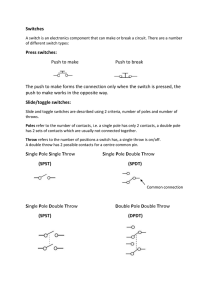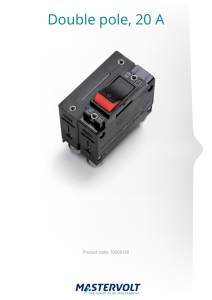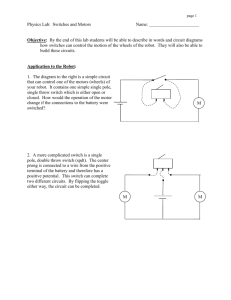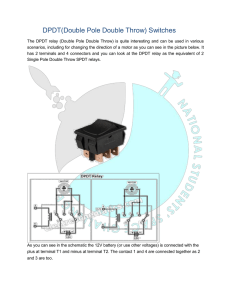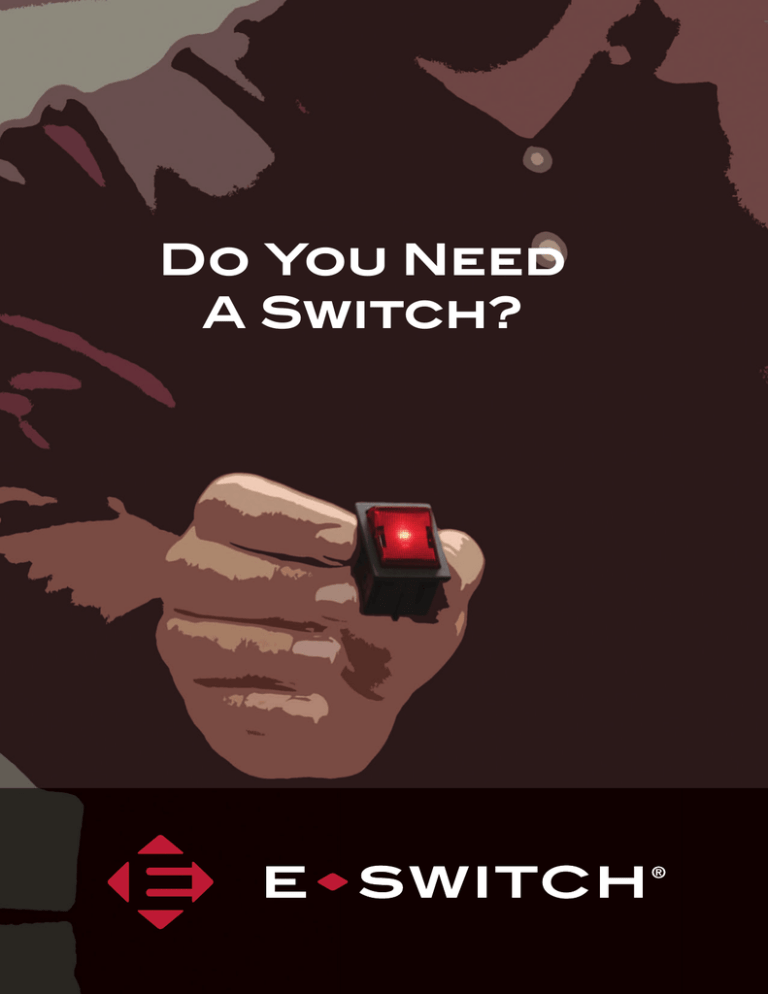
Do You Need
A Switch?
Questions to ask when specifying a switch
1
WHAT TYPE OF SWITCH ARE YOU LOOKING FOR?
The switch categories below show the different types to choose from.
2
Anti-vandal
Detector
DIP
Keylock
Navigation
Pushbutton
Push-pull
Rocker
Rotary
Slide
Snap-action
Tactile
Tilt
Toggle
Trigger
WHAT ELECTRICAL RATINGS ARE NEEDED?
1. Is the product AC or DC?
• Common Voltages for AC: 125VAC, 250VAC
• Common Voltages for DC: 3, 6, 12, 24 and 48VDC
2. How many amperes does the switch need to handle?
• Low Power is in the milliamps
• Medium Power is from 2 amps to 5 amps
• High Power is greater than 6 amps
3. If you’re looking at medium to high power, what agency approvals are needed?
• Where the product is sold determines what approvals are needed.
(cULus)
North American Agency
(ENEC)
European Agency
(VDE)
German Agency
(TUV)
Worldwide Agency
3
HOW MANY POLES AND THROWS DO YOU NEED?
Poles are the number of closed independent circuits.
Throws are the number of positions in which a given pole is closed.
Common pole/throw configurations are:
SPST
Single Pole, Single Throw
SPDT
Single Pole, Double Throw
DPST
Double Pole, Single Throw
DPDT
Double Pole, Double Throw
Basic examples of above configurations are:
SPST - Flashlight: 1 pole for turning the light on or off.
SPDT - Vacuum Cleaner: 1 pole for power, 1 throw for low speed, 1 throw for high speed.
DPST - Air Conditioner: 1 pole controls the chiller, 1 pole controls the fan.
DPDT - Hair Dryer: 1 pole controls the heater, 1 pole controls the fan, 1 throw is for low speed, 1 throw
is for high speed.
4
HOW DOES THE SWITCH ATTACH TO YOUR PRODUCT?
1. Panel Mount
• What is the panel cutout size?
• What is the thickness of the panel?
• What type of termination?
» Quick connect or solder lug
2. PC Board Mount
• What type of termination?
» Through hole or surface mount
• What type of actuation?
» Right angle or vertical
• Do you need a process sealed component?
Panel Mount
Through Hole
Quick Connect
Surface Mount
Solder Lug
Right Angle Actuation
Vertical Actuation
5
WHAT IS YOUR APPLICATION?
Knowing the application that the switch goes into aids us in the ability to look for unique instances where
certain switches work better than others. Below are some examples of industries we sell our switches to.
6
Audio / Visual
Computer Peripherals
Consumer Electronics
Electrical Housewares
Floor Care Appliances
Gaming and Computer
Handheld Devices
Industrial Controls
Instrumentation
Medical Equipment
Security Devices
White Goods
ARE THERE ANY ADDITIONAL REQUIREMENTS?
Many products have requirements that are not initially thought of. Some might make the switch more
aesthetically pleasing and others will help the switch perform better under special circumstances. Below
are examples that should be brought up during discussion:
•
•
•
•
•
•
•
•
7
Momentary or Latching
Illumination
Sealed Protection (IP Rating)
Custom Cap Options
» Colors
» Graphics
» Styles
Long Life Expectancy
High Inrush or Horse Power Rating
Extreme Temperature Rating
Custom User Requirements
WHAT IS THE ESTIMATED ANNUAL USAGE (EAU)?
If you are looking for a custom switch, it is important to know an accurate EAU for your project. Once
we know, we are able to determine how feasible certain customizations are. Since unique requirements
sometimes incur additional tooling charges, knowing in the beginning will help expedite the process.
CALL NOW!
to talk to an E-Switch engineer
(800) 867-2717
www.e-switch.com
GLOSSARY OF TERMS
Actuator: The mechanical interface between the basic switch contacts and the means of
operation, such as the operator’s finger.
Pre Travel: The movement of the actuator prior to closing the circuit. Sometimes identical to
“Travel to Make”.
Actuation Force: The required force to change a circuit’s electrical state.
Reset Point: Point at which contact resumes normal position. Single-Break: Mechanism that
transfers one contact.
Alternate Action Switch: A Pushbutton style switch where the change of the electrical state is
maintained between actuations.
Ampere: A unit of electrical current flow.
Base (Housing): A base of a switch is the main member to which the conducting parts or insulator unit are attached. It may also have parts of the operating or control mechanism attached.
Bounce: Rebounding of moving contact against fixed contact during transfer.
Break: Interruption of a circuit. Double-break occurs when a single mechanism interrupts two
contacts simultaneously.
Break Before Make: The term given to a double throw switch where the first circuit is opened
before the second circuit is closed.
Single Throw Switch: A single throw switch is a switch by means of which the circuit can be
opened or closed by moving the switch blade into or out of one set of contacts only.
Snap Action: The abrupt transfer of contacts from one position to another. This action is
relatively independent of the speed of actuator travel.
Splash Proof: Sealed switch will withstand heavy rain or stream of water.
Switch: A switch is a device for making, breaking, or changing the connections in an electric
circuit.
Switch Abbreviations:
N.C.: Normally Closed circuit
Capacity: Usually refers to the current handling capability of a switch.
N.O.: Normally Open circuit
Chatter: Rapid opening and closing of contacts, usually exhibited during extreme vibration
and/or shock.
SPST: Single Pole Single Throw
Clearance (Spacing): Distance through air between electrically live parts of opposite polarity
or to ground.
Contact: The contact is a conducting part designed to be united by pressure to another conducting part for the purpose of carrying current.
Contact Bounce: Oscillation of the movable contact upon closure of the circuit.
Contact Gap: The minimum distance between the fixed and moveable contacts.
Contact Resistance: The resistance of current flow across closed contacts.
Dead-Break: Open circuit condition, usually caused when slowly actuating snap-action
switches. Results from low contact pressure or contact lift-off.
Detent: Feature that indicates actuation point has been reached. Can also be referred to as
tactile feel.
Dielectric Strength: The ability of an insulating material to resist voltage from arcing across
its surface.
SPDT: Single Pole Double Throw
DPST: Double Pole Single Throw
DPDT: Double Pole Double Throw
MBB: Make Before Break
BBM: Break Before Make
Throw: The term denotes the number of positions in which a given pole is closed.
Travel to Make: The distance parallel to the designated direction of the actuator movement at
which point a circuit is closed.
Watertight: Sealed switch will withstand submersion to various depths depending on specification level.
Wiping Action: Lateral travel of movable contact over fixed contact while pressure between
the two contacts exists. Occurs during plunger travel. This action helps clean the contacts of
contamination.
Differential: Distance between trip point (or force) and reset point (or force).
Double-Break: A mechanism that breaks the circuit at two points simultaneously by means of
a “shorting bar” like device.
IP Rating Chart
Double-Throw: Contact arrangement that alternately transfers normally open and normally
closed circuits.
First Number
Dust-Tight: Sealed switch will withstand sand and dust contamination.
Protection against
solid objects
Electrical Life: Expected cycle life when switch is operated at full rated load.
0
Free Position: Point at which plunger exists in the un-operated condition.
1
Insulation Resistance: The resistance to current flow of the insulating materials between
contacts.
2
Lever Actuator: A device, hinged or spring type, applied to a basic switch to facilitate its application.
3
Make Before Break: The term given to a double throw switch when the second circuit is
closed before the first circuit is opened.
Momentary Action Switch: The term given to a switch where a circuit is continuously closed
or opened only when force is applied. The electrical state returns to its normal position when
the force is removed.
Operating Point: Point at which contacts transfer. Usually measured from the switch mounting
holes.
Second Number
No protection
Protected against solid
objects over 50mm (e.g.
accidental touch by hands)
Protected against solid
objects over 12mm (e.g.
fingers)
Protected against solid
objects over 2.5mm (e.g.
tools and wires)
0
No protection
1
Protected against vertically
falling drops of water
2
Protected against direct sprays
up to 15° from the vertical
3
Protected against direct sprays
up to 60° from vertical
Protected against solid
objects over 1mm (e.g.
tools, wires and small wires)
4
Protected against sprays from
all directions - limited ingress
permitted
5
Protected against dust limited ingress (no harmful
deposit)
5
Protected against low pressure
jets if water from all directions
- limited ingress permitted
6
Totally protected against
dust
6
7
Over Travel: The distance an actuator travels after the circuit is closed.
Pole: The term to denote a completely separate circuit, which passes through a switch at one
time.
Definition
Protection against
liquids
4
Normally Closed: The term given to a switch where a circuit is closed in the normal switch
position.
Normally Open: The term given to a switch where a circuit is open in the normal switch position.
Definition
8
Protected against strong
jets of water e.g. for use on
shipdecks - limited ingress
permitted
Protected against the effects of
temporary immersion between
15cm and 1m. Duration of test
30 min.
Protected against long periods
of immersion under pressure
E-Switch Worldwide Headquarters:
E-Switch Asia Sales Office:
Address: 7153 Northland Drive N
Minneapolis, MN 55428-1514
USA
Phone: 763-504-3525
Toll Free (USA): 800-867-2717
Fax: 763-531-8235
Address: Gateway East, Level 28
152 Beach Road, Suite 38
Singapore 189721
Phone: +65 6827-5620
Fax: +65 6294-2602
Website: www.e-switch.com
CALL NOW!
to talk to an E-Switch engineer
Brochure Version: June 2015
(800) 867-2717
www.e-switch.com
© 2015 E-Switch Inc. All Rights Reserved. E-Switch, Inc. is a wholly owned subsidiary of Stein Industries, Inc.

